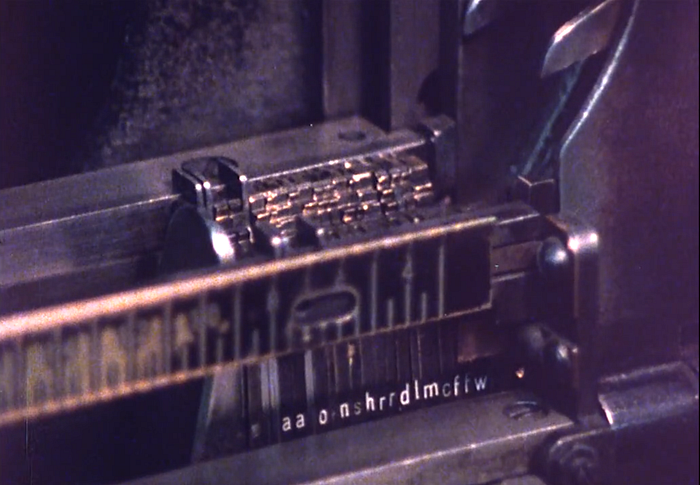
In July 1978, the New York Times transitioned from a hot-type to a cold-type system — from cast metal typesetting with red hot metal to the quiet, cool computer-based systems still employed in principle today.
The video exploring the transition between these systems is worth watching if you have the time, for a number of reasons, not the least of which is the view of the modern computer systems put in place.
A number of interesting items jump out in both the old system and the new — including the ferocious speed at which they were able to cast metal — but the most intriguing item was also one of the most minute: a small animation on the new computer systems for the typists. Any time a writer sitting at one of the typist’s terminals finished composing an article, they would press a button to “send” it off to the editor for review. At that point, the article would appear to roll up the screen, curling in at the top as it “left” the typist’s viewscreen and presumably went off to the editor’s terminal.
Of all things, you’d imagine that kind of animation to be a triviality. In a sense, it is — it doesn’t impact the actual production process, nor change the words that are put on the paper. But that fact makes it all the more pertinent in the context of those writers. We’re so adjusted today to minor animations and other decorations used to gloss up the computing systems we use. They’re very easy to add, and half the time we don’t even notice them except when they are absent. But in the ’70s, adding such an animation was no trivial task. The computing power required for that to occur, on each terminal, every time a writer completed a page was an investment, as was the time taken by the system’s programmers to implement it. So why bother? The writers needed to learn a new system anyway; why not let them adjust to thinking about the page they wrote as virtual rather than a physical page delivered to the editor?
There were many adjustments that the writers in that office needed to make: A new keyboard layout, new methods for organizing content on pages, the ins and outs of a software system — for many who had never before touched a computer. Now it would become a part of their daily workflow.
For any typist in that office, the process of turning words into clean, readable, digestible pages of a newspaper was a craft. It’s difficult for us in the age of one-off articles and automated newsletters to think about it this way, but the fundaments of what made a newspaper excel persisted from the old system into the new, and came along with the writers as they transitioned to the new system. It was this sense of artistry and experience that needed preserving in order to achieve success. Not every individual working at the NYT (or other offices, undergoing the same inevitable change) could adjust; it involved a complete readjustment of decades of work experience.
One worker who did make the transition put it so:
I’ve learned the new stuff, the new processes and all, but I’ve been a printer for twenty-six years…six years apprenticeship; twenty years journeyman — and these are words that aren’t just tossed around. They’ve always meant something to us printers.
And it’s inevitable that we’re going to go into computers; all the knowledge I’ve acquired over these twenty-six years is all locked up in a little box now called a computer….
Even those who made the transition, who stuck it out to the new system, who effectively threw out years and decades of accumulated knowledge to make way for technology, felt the impact of what was changing.
That one little animation of a page rolling out of the top of the screen bridged this technological gap. It emphasized for the typists that their jobs were still fundamentally the same: You may sit in a different place, type on a keyboard connected to a computer terminal rather than on a mechanical board, the issues you encounter will be electrical rather than mechanical, but at the end of the day the work you do persists for the same purpose, still goes to the same place, still ends in the same goal.
That is the reason for the animation; that is the reason for the time and money spent implementing a minor flourish— to keep the worker in the game, to help them transition, to subtly but clearly remind them that while the system has changed, the crux and value of their work has not.
It’s a valuable lesson for today’s workplace, which is far more transient than most any workplace in the 1970s when this transition and many similar ones took place. When change comes, it comes as much for the worker as for the work itself. A system that changes isn’t just a swapping out of components, or a financial trade-off, but an impact on the nature and culture of a workplace. Recognizing the value of the experience gathered right under your roof produces a transformative impact on the relationship between the organization and the individuals who work there. An investment in the worker is an investment in the business. The profit of loyalty is significant — and it’s a two-way street.
* * *
That same worker quoted above, speaking about how the new computer systems replaced the old ways and would do most of the work, brought it together with one pertinent last statement:
I think probably most jobs are going to end up the same way.